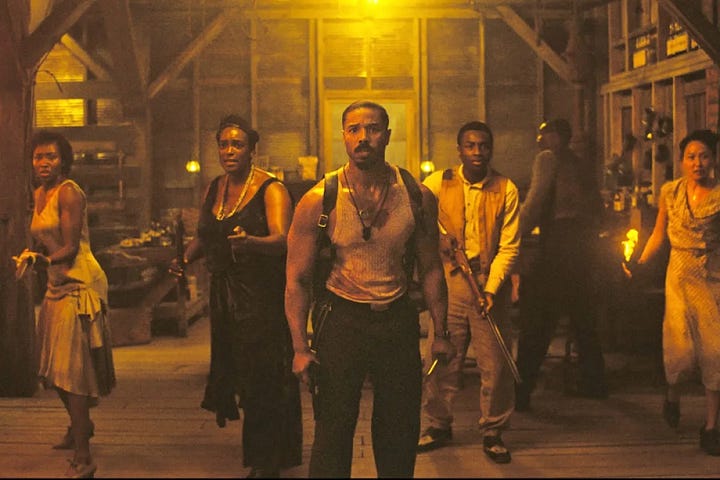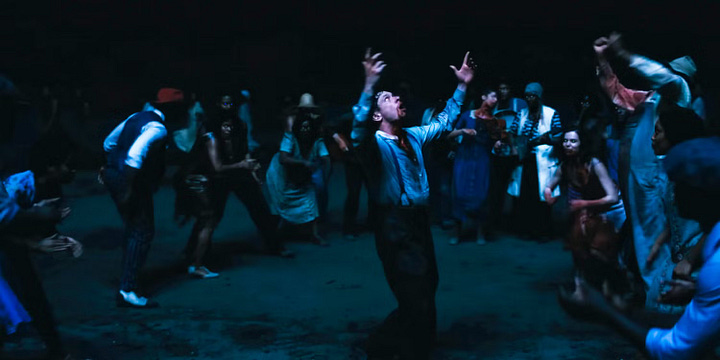

Do you find there are articles or podcasts, for instance, that you can’t really engage with, because they seem all worked up over questions you feel like you dealt with long ago? It’s not that they’re “bad,” necessarily, but they just don’t speak to where you’re at, so they make you impatient or annoyed. It’s more complicated when it comes to works of art. Unless they’re incredibly didactic, novels or films or songs operate on multiple levels beyond any subject-matter-based “argument.” But that dynamic can still undermine your enjoyment.
I’m thinking about why I was disappointed by Sinners, the Ryan Coogler movie that both critics and audiences seem to adore this season. Some of it’s just the messy pacing and plotting in the film’s back half, which lots of people have noted and excused. More frustrating to me, though, are the broad and often slapdash ways it handles the music-and-culture issues at its heart, in those same sequences. If you’d asked me a few weeks ago, “Would you want to see a historical fantasy vampire movie that was an allegory for Black Southern cultural exploitation?” my answer would have been “hell yeah.” But I ended up feeling like the wrong audience for it, precisely because that was what I was excited about.
An easier example might be A Complete Unknown—it was clear I had too much info and too many opinions about Bob Dylan to be its ideal viewer. With Sinners, I grant my own racial standpoint could also be a destabilizing factor. Though plenty of white critics have been over the moon about it, while a few Black critics have been similarly ambivalent. In any case, all the themes and ideas the film throws into the air—ambitions that are gorgeously wild for a Hollywood product—don’t overcome my misgivings about how awkwardly they land.
(spoilers follow from here)
I’m going to tell you everything I liked first. Because the first half or more of Sinners is great—a brilliant procedural about how to put on an illegal juke joint in the segregated South, specifically 1932 in the Mississippi Delta. I was rapt through all of it. The process becomes a travelogue through social layers, from sharecropping out to details like the wide town drag on which there’s a white side of the street and a Black side that have no contact, save for a Chinese-American shopkeeping family that’s able to be a conduit between the two. All fitting to the period and place.
Michael B. Jordan’s virtuosically filmed Smoke and Stack twin characters also illuminate (worn lightly) the back-and-forths we seldom talk about in the Great Migration, the impacts of the first world war on Black veterans, the intermingled effects of Jim Crow and Prohibition. Hailee Steinfeld’s Mary incarnates the paradoxes of “passing,” of “one-drop” blood-quantum regimes, of anti-miscegenation laws (and their close links to lynching), and more.
The preacher father’s warnings to his guitar-slinging son Sammie about playing the devil’s music take place in that high risk context, avoiding any kind of shallow mockery of Christian piety. There’s no crap about Robert Johnson’s deal-with-the-devil mythos, beloved of white blues audiences who don’t think about how exoticizing and patronizing of Black musicians it is. Instead we get (as backstory) the fantastic Delroy Lindo’s harp-wizard bluesman with his soul-sucking deal with white audiences, who want Black music but consider the humans who make it expendable or worse (back to lynching’s ever-present menace). Then there’s Wunmi Mosaku’s Annie, whose syncretic hoodoo practices are treated with a care practically never seen in mainstream American film before. (That said, Annie and Smoke’s “afterlife moment” near the end was kitschy Black-Madonna hokum, sorry!)
The sex is sexy, and its mild obsession with cunnilingus is both funny and awesome. The oral fixation seems fitting for a vampire movie, while deflating SuperShaft stereotypes in a film that foregrounds Black and mostly male power and pleasure.
The dangers of getting financing from the local white power structure—the Klan never being more than one degree away—also ring harrowingly true. And that’s what the ultimate climax (and/or anti-climax) turns out to be. So with those real-life villains available, did this movie ever actually need vampires? Other than as a pop hook to hang it on, of course. It’s a big Hollywood movie, so let’s allow that the genre hook is a commercial necessity. (At least he didn’t make it as a literal superhero movie.) You still have to ask, What do the effin’ vampires mean in the context you’ve established, then? We’ll get back to that very shortly.
I was fine with the over-sauced voiceover setup at the start about musical griots as healers and spiritual go-betweens. But then we get the scene in the juke joint where the voiceover is repeated while Sammie plays the blues, and it’s illustrated extremely literally by the spectral appearances of African musical ancestors, then rock’n’rollers, then a facsimile of Bootsy Collins playing guitar instead of bass, and finally a hip-hop DJ, and we’re totally in educational-cartoon land. Sure, nudge us via an otherwise non-existent narrator about how the blues goes back and forth in time, or else find some more elegant way to show it visually. But doing clunky versions of both simultaneously is to gild the lily with foot-thick lead paint. The visuals are the stuff of old iPod ads or CNN faux-documentary montages made for a social-studies teacher. Sorry to be snobbish but I just immediately laughed at it. And while I want to think Coogler was maybe giggling too, I’m not confident.
Let’s pause to ask wtf was going on in the score. I’ve enjoyed Ludwig Göransson’s work in films before (including Coogler’s), but the ham-handedness here was distracting and again inadvertently comical for its pick-me shouts of “hey, look, I’m crossing genres.” Which I’d be prepared to overlook if so often Göransson didn’t start blaring his shit all over the great diegetic music in the performance scenes, whether by Sammie or the all-singing-all-dancing vampires or, most egregiously, overtop of freakin’ Buddy Guy in the post-credits sequence. As so often in this film—given the extraordinary final-cut deal he negotiated—there seems to have been no one with the ability to whisper to Coogler, “How about we just pull back a step? Please?”
Okay, back to the vampires. When we came out of the film, my friend said, “Wasn’t that just From Dusk till Dawn?” But I had another template in mind: The aforementioned A Complete Unknown, in which the villains are also white folk musicians, as the vampires turn out to be in Sinners. Even in the Dylan movie, as I’ve argued at length, it’s a bit vexing to decode exactly why the folkies are the bad guys, but it can be done. I defy you to explain it in Sinners.
When I first heard about Sinners, I thought, “Okay, so the vampires are white expropriators who want to suck the blood from the blues for pleasure and profit, like 1950s record companies or sixties white rock guitarists or, lSater, white suburban hip-hop fans? Very on-the-nose, but a great Jordan Peele-esque satirical ‘social horror’ premise, right?”
Instead, though, Coogler seems to want his signifiers to run two opposite ways at once, and the ambition defeats any coherence. By making the central vampire Remmick a charismatic traditional Irish musician who talks about wanting to absorb the essence of the blues into some kind of difference-flattening musical utopia (and in mutual opposition to the Klan), but then continues to play only Irish music even after bloodsucking a bunch of the Black musicians and patrons at the juke joint, the allegory falls apart.
The Irish music we hear is as potent and rooted as the African-American sounds, just as in the real world. Coogler seems to have in mind the commonalities of the two diasporic tribes, oppressed and exiled and then stigmatized by phenomena like the “no Blacks, no Irish” signage of that era. However, that Irish experience was way more of a northeastern thing than a Southern one (although the anti-Catholicism of the Klan was of course real). And again, what happened to the cultural-appropriation metaphor? To put it another way, why are they vampires?
If the fantastic step-dancing rendition of that upbeat ballad of cultural exile “Rocky Road to Dublin” had morphed into some kind of blues hybrid (Thin Lizzy-style, maybe?), that would have held together a little bit. Overall, though, it would have been way truer to Southern history to leave Irishness out of this particular scenario in favour of nearer-by parasitic blues collectors, singers, and marketers, like vampire Lomaxes and Elvises and Sam Phillipsi. As it was, any throughline felt as flimsy as the idea that this apparently cunning and powerful vampire would be so sloppy as to ignore completely that the sun was coming up on the verge of his victory. How the hell is he supposed to have survived all the centuries since the dispossession of old Eire?
Then, in the post-credit sequence, we get the revelation in a 1990s Chicago blues club that Sammie grows up to be a fictional equivalent of Buddy Guy, played by Guy himself, who also came out of a sharecropping family in the 1930s. There’s a whole thing about how the vampires secretly left him alone to follow his own path. But that just makes one think about what music-biz vampires actually did to Buddy Guy: They tried to force him to conform to white notions of marketable blues “authenticity,” refusing to support his own modernist innovations until they were already old enough to be marketed as sepia-toned history themselves.
That lineage is reminiscent of the accusations of the Lomaxes making Lead Belly wear prison togs on stage and exclude the pop tunes in his repertoire. And again of the general authenticity fetish in folk and blues revivalists’ leftie ideologies, as at the Newport festival in 1965, which could serve to police racial boundaries in their own way, even in the name of civil rights. But Coogler’s vampire story doesn’t do anything with any of that, so the Buddy Guy bit comes off to me as a cheap sentimental footnote.
It’s like Sinners is two films, a galvanizing first chapter and a dispiriting sequel. The second one’s treatment of this rich cultural lore devolves into corny Hollywood gobbledygook. At least it’s not just more assembly-line “intellectual property” being repackaged for easy box office (yet). On that level its success could be salutary for an increasingly hollowed-out industry. But I left the theatre feeling like my own hopes for it, and some of my vital fluids, also had been drained.



Can't thank you enough for this methodical analysis. In terms of narrative structure, the second half simply falls apart. It lacks the drama, pacing, conflict, and ensemble -- the thematics too -- that made the first half a breakthrough vision of 1932 Mississippi. The vampire metaphor bloody dies on the vine, while the Irish are misplaced and ill-served. I had to read several rave reviews just to understand what people were seeing that I wasn't. Hat's off.
My read was … vampirism as unification process for oppressed people’s , helping fortify against the real WASP enemy . The WASPs were never offered eternal life , just a violent, raging death by machine gun fire . The Irish and blues music were still stylistically different , but functionally the same . I thought that was the point . But I’m a romantic .